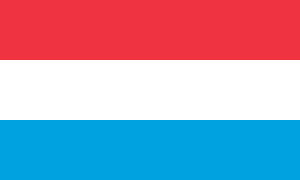
| Colors | HEX Code | RGB | CMYK |
|---|---|---|---|
| Red | #EB3340 | 235, 51, 64 | 0, 78, 73, 8 |
| White | #FFFFFF | 255, 255, 255 | 0, 0, 0, 0 |
| Light Blue | #00A3E0 | 0, 163, 224 | 100, 27, 0, 12 |
The flag of Luxembourg is a tricolor with three horizontal stripes colored red, white, and light blue from top to bottom. It is similar to the flag of the Netherlands, but the shades of red and blue are lighter.
Meaning of Luxembourg’s Flag
The colors of the flag of Luxembourg are inspired by the coat of arms of the Grand Duchy, which featured a striped blue and white background with a rampant red lion. The colors have no specific meanings, but they represent the history of the country.
History of Luxembourg’s flag
Luxembourg was a duchy in the Holy Roman Empire and did not need a flag to represent it. It rather had a banner that probably was in use since the 13th century, with white and blue stripes and a red lion. After the defeat of the Holy Roman Empire in the Napoleonic wars, it entered a union with the Netherlands in 1815. Luxembourg was administered by the Dutch monarchy but remained a separate entity from the Netherlands. On June 12, 1845, Luxembourg adopted a tricolor of horizontal stripes of red, white, and blue, inspired by the coat of arms of the Grand Duchy. When its independence was recognized in 1867, the flag did not change. Before WWII there were attempts to restore the old banner as the national flag, but when Luxembourg was occupied by Nazi Germany, the flag did not change. It has remained unchanged since its adoption in 1845.